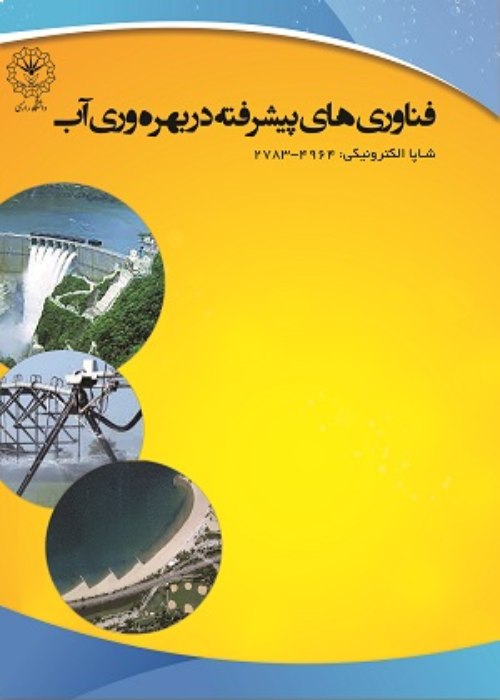Application of pump as turbine in extracting surplus energy of water transmission lines
Author(s):
Article Type:
Research/Original Article (دارای رتبه معتبر)
Abstract:
Electricity production is very important in developing countries. Undoubtedly, energy production is a key factor for the economic and social development of these countries. Institutions involved in electricity supply have recently recommended pump as turbine as an option for electrifying villages due to economic benefits. Electricity generation from transmission lines and water distribution networks is one of the new topics in the optimal management of water systems. In water transmission and distribution networks, despite the additional water load on the downstream equipment, which is often controlled by pressure control valves, a pump can be used as a turbine in electricity production. By taking energy from the pump and transferring it to the incompressible fluid, the pumping system increases the energy of the fluid and transfers it from a lower height to a higher level, while the reverse pump system works in the opposite direction of the pump. One of the most important factors in choosing the type of turbine for the construction of a power plant is the estimation of the initial costs of the project for the initial cost return in the shortest time. For this reason, according to the results of the investigations, one of the economic methods to replace the turbine is to use a reverse pump. These types of pumps have features such as lower maintenance costs than turbines and can be widely used.The case study in the present research includes the water supply plan to the cities and villages in the northeast of Khuzestan, which consists of a set of transmission lines, pressure relief valves, balance tanks and water storage tanks. The studied area in Khuzestan province includes the cities of Baghmalek, Izeh, Seydun and Ramhormoz. Seydun reservoirs in the east, Haftgel reservoirs in the west, Ramhormoz reservoirs in the south, and Izeh reservoirs in the north of the study area. According to the profile of the studied water supply line, there can be excess energy in the pressure relief valves, the inlet of the water tanks and the balance tanks. Based on this, eight points in the form of Helaijan branch, Seydon reservoirs, PRV6 pressure relief valve, RES5 equilibrium reservoir, RES6 equilibrium reservoir, Haftgel reservoirs, Ramhormoz reservoirs and Baghmalek reservoirs were selected as points with the potential of using reverse pump for energy production. Manufacturers of pumps usually do not provide the curve of pump behaviors in reverse operation, which causes problems in using the pump as a turbine. It is not easy to use the pump as a turbine, and the pump shows different behavior, which makes it difficult to predict the characteristic curve. For this purpose, it is necessary to convert the characteristic curve of the selected pump into the characteristic curve of the reverse pump. In this research, Sharma's method (1985) was used to determine the suitable pump for a small hydroelectric power plant. This method helps to select a pump with reverse operation capability according to the available line information so that it can be used as a turbine for energy extraction with the help of a generator. According to all the available methods for selecting the pump, this method provides the closest results to the user, and along with the practicality of its use, empirical equations are used in this method.Based on the amount of production power calculated for each of the points with energy production potential, it was determined that the maximum production power of RES6 balance tank and PRV6 pressure relief valve is 758.7 and 719.5 kW, respectively. The RES6 balance tank has the maximum head and the PRV6 pressure relief valve has the highest flow rate among all the studied points. The lowest production power is related to Helaijan branch with 32 kW, which is the lowest flow rate among all the studied points. Based on the obtained results, the proposed power plants are able to supply 1512 kilowatts of production power. In the next part, the proposed replacement of small hydropower plants on the transmission line with diesel generators with similar production capacity was analyzed from an economic point of view. In these calculations, the efficiency of the power plant is considered to be 75%. The total power produced by small hydropower plants with reverse pump is equal to 2717.29 kilowatts, which, considering 8000 hours per year for a period of 25 years, will be equal to 302400 megawatt hours. Considering that 10.96 kilowatt hours of power is produced per liter of diesel, the total amount of fuel required for a period of 25 years will be equal to 27600000 liters. Considering the world price of diesel, which is about $0.5 per liter, the cost of fuel required for energy production will be about $13,800,000.
Keywords:
Energy , water systems , reverse pump , CO2
Language:
Persian
Published:
Journal of Advanced Technologies in Water Efficiency, Volume:3 Issue: 2, 2023
Pages:
91 to 106
magiran.com/p2632630
دانلود و مطالعه متن این مقاله با یکی از روشهای زیر امکان پذیر است:
اشتراک شخصی
با عضویت و پرداخت آنلاین حق اشتراک یکساله به مبلغ 1,390,000ريال میتوانید 70 عنوان مطلب دانلود کنید!
اشتراک سازمانی
به کتابخانه دانشگاه یا محل کار خود پیشنهاد کنید تا اشتراک سازمانی این پایگاه را برای دسترسی نامحدود همه کاربران به متن مطالب تهیه نمایند!
توجه!
- حق عضویت دریافتی صرف حمایت از نشریات عضو و نگهداری، تکمیل و توسعه مگیران میشود.
- پرداخت حق اشتراک و دانلود مقالات اجازه بازنشر آن در سایر رسانههای چاپی و دیجیتال را به کاربر نمیدهد.
In order to view content subscription is required
Personal subscription
Subscribe magiran.com for 70 € euros via PayPal and download 70 articles during a year.
Organization subscription
Please contact us to subscribe your university or library for unlimited access!


